The Voltaic Cell computer simulation is used to measure the E°cell generated by an electrochemical cell incorporating a standard hydrogen electrode as one of the half-cells. Connect the more active half-cell to the "ground or black" terminal of the voltmeter using a black colored wire. Connect the less active half-cell to the "red" terminal of the voltmeter using red colored wire. This measures the voltage generated by the cell reaction. Once the voltage of the cell is recorded one can determine the reduction potentials of the half-cells. For example, since the voltage generated by a standard hydrogen electrode has been assigned 0.0 Volts, when SHE||Cu2+|Cu and Zn|Zn2+||SHE electrochemical cells are investigated
2H+(aq) + 2e- -> H2(g, 1 atm) E° = 0.0 Volts
H2(g, 1 atm)) --> 2H+(aq) + 2e- E° = 0.0 Volts
one can determine the standard reduction potentials of half-reactions written as reduction potentials:
Cu2++ 2e- -> Cu E° = +0.34 V
Zn2++ 2e- -> Zn E° = -0.76 V
Computer Simulation SHE:
Connecting the more active half-cell to the "ground or black" terminal of the voltmeter (using black wires) allows for a measurment of the voltage generated by the cell. Once the voltage is recorded one can determine the reduction potential of the half-cells.
The following images are snap shots from the Galvanic/Voltaic Cells 1 simulation. The image on the left is a Zn|Zn2+|| SHE cell and the image on the right is a SHE || Cu|Cu2+ cell.
 | 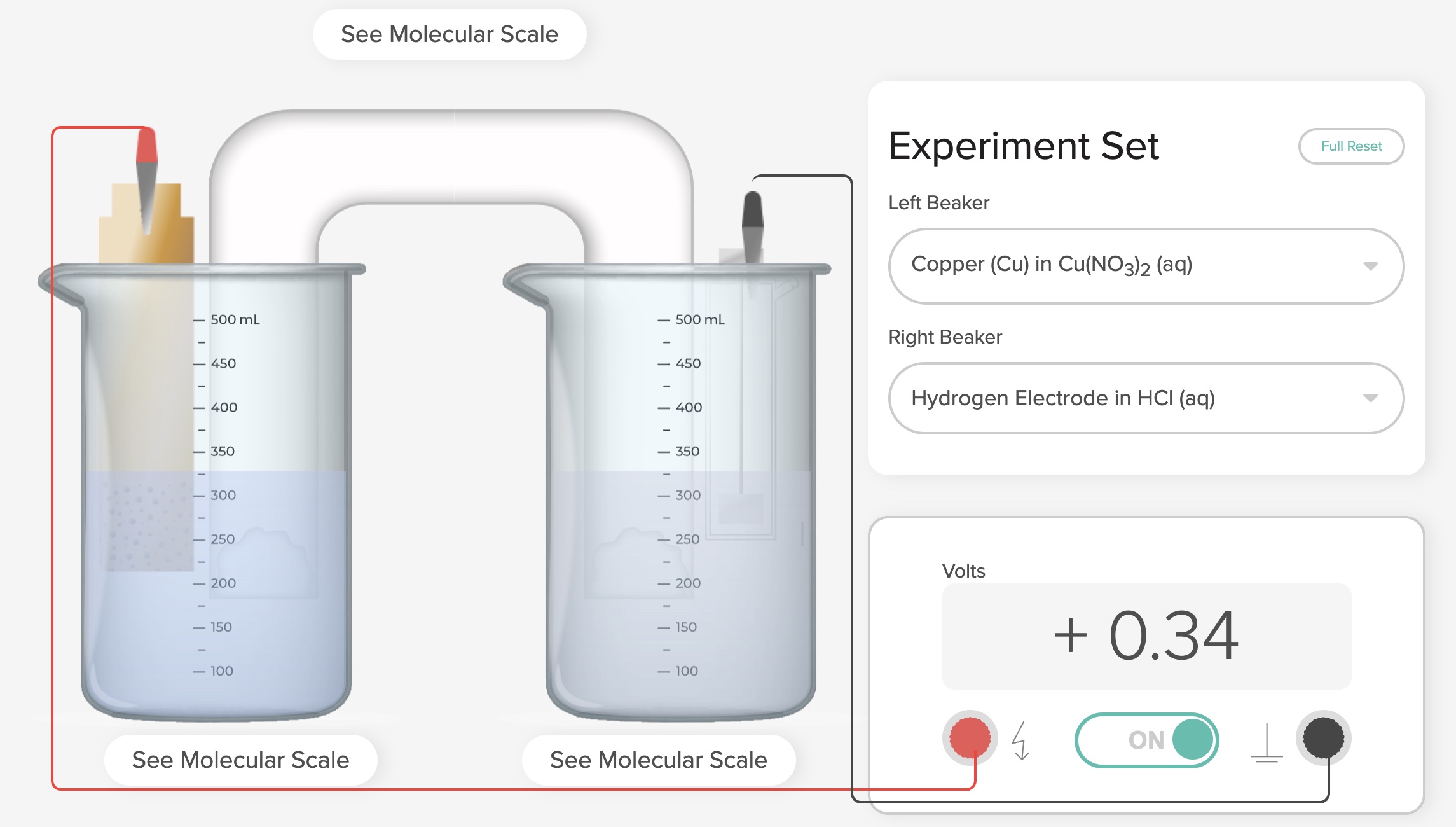 |
https://teachchemistry.org/classroom-resources/voltaic-cells
Greenbowe, T.J.; Gelder, J.I., Boyd, A, Wixon, M. (2020). Galvanic/Voltaic Cells 1. American Chemical Society, American Association of Chemistry Teachers, American Chemical Society: Washington, D.C.
If you use the Galvanic/Voltaic Cells 1 simulation, please properly cite the simulation. The Galvanic/Voltaic Cells 1 may not be used in any lesson sold for profit.
The simulation has animations at the particle level of what occurs at the surface of a platinum electrode in a Standard Hydrogen Electrode (SHE). A H2(g) tank serves as the source of H2(g) being bubbled into the SHE onto a platinum electode with "platinum black" on the end (acts as a catalyst) in1.00 M HCl(aq) at 25°C, 1.00 atm pressure, near sea level. Electrons are shown reducing two H+ ions to H2(gas) when the electrochemical cell contains a more active metal in a half-cell, for example a zinc half-cell. In this case the standard hydrogen electrode serves as the cathode. Hydrogen gas is oxidized to two H+ ions, showing a release of two electrons when connected to a less active metal in a half-cell, for example copper half-cell. In this case the standard hydrogen electrode serves as the anode. The following image depicts one frame in an animation of the process that occurs in a standard hydrogen electrode (SHE).
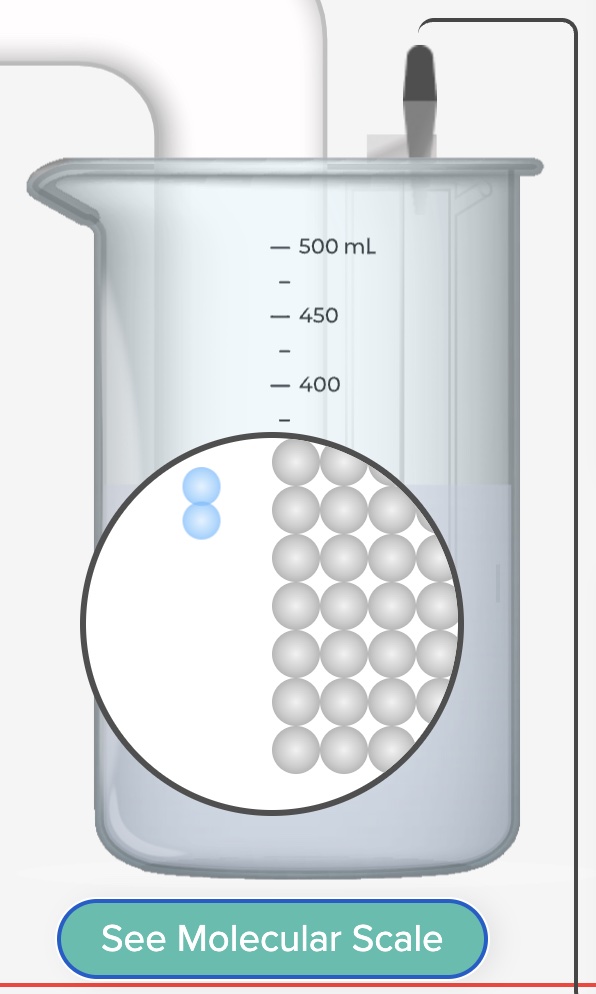
Silver and magnesium are two additional metals available for investigation.
Web page author: T. Greenbowe, University of Oregon. This page is under construction.
When showing a real SHE metal electrode cell, for example Zn|Zn2+|| SHE as a demonstration or as a simulation make the connections to the voltmeter such that the more active half-cell is connected to the "ground" terminal of the voltmeter or the "black terminal". The voltmeter should record a positive voltage for the cell.
Let's briefly discuss what occurs when the zinc half-cell is connected to the "ground terminal or black" of the voltmeter and the standard hydrogen electrode half-cell is connected to the "red" terminal of the voltmeter. This voltmeter will show a positive voltage. The cell reaction is spontaneous process if it generates electricity. This calls for a positive E°cell value. See the image above for a zinc SHE cell.
Zinc serves as the anode because zinc is a more active metal compared to the SHE. Oxidation occurs at the anode.
Zn -> Zn2+ + 2e-
2H+(aq) + 2e- -> H2(g, 1 atm)
The SHE half-cell serves as the cathode in this electrochemical cell.
The cell reaction is Zn + 2H+(aq) -> Zn2+ + H2(g) and the E°cell = +0.76 V
The voltmeter is measuring the emf of the cell reaction. Since eletricity is being produced by a chemical reaction, the emf is a positive value. The voltmeter is NOT measuring the voltage of a half-cell! We have some work to do to determine the voltage of the half-cell.
By definition, the SHE reduction potential is zero volts.
2H+(aq) + 2e- -> H2(g, 1 atm) E° = 0.0 V
Standard reduction potentials are all written as reduction half-reactions. The goal is to determine the value of E° of the zinc half-cell as a reduction half-reaction.
Zn2+ + 2e- -> Zn E° = ?
The measured cell potential (emf) is +0.76 Volts. The cell is producing electricity from a chemical reaction, therefore the emf is positive. Zinc is the more active metal compared to the 2H+/H2 half cell. The zinc metal serves as the anode. An oxidation half reaction occurs at the anode.
The emf of a cell is the potential difference between two half-cells. Using the potential difference approach, allows for the determination of E° of the zinc half-cell as a reduction reaction.
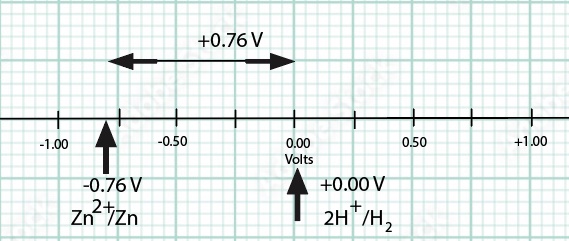
E°cell = E°reduction (Cathode) - E°reduction (Anode) Using this formula, all E° values are reduction potentials.
E°cell = = 0.0 V - E°reduction (Anode) = +0.76 V
-E°reduction (Anode) = +0.76 V - 0.0 V
E°reduction (Anode) = -0.76 V
Zn2++ 2e- -> Zn E° = -0.76 V Note: the zinc half-cell reaction is written as a standard reduction half-reaction.
However, when the cell is operating the zinc half-cell will have an oxidation half-reaction, see next section for a discussion.
Zn -> Zn2++ 2e- (an oxidation half-reaction, occurs at the anode)
***
Animations at the Particle Level of Representation
The simulation has animations at the particle level of the process that occurs at the surface of the SHE platinum electrode when it serves as an anode and when it serves as a cathode.
In the case of the the zinc half-cell connected to a SHE, the animation shows what occurs when the SHE serves as a cathode and zinc serves as the anode.
2H+(aq) + 2e- --> H2(g) (a reduction half-reaction, occurs at the cathode) [Currently Firefox is able to play the animations.]
Zinc serves as the anode because zinc is a more active metal compared to the SHE. Oxidation occurs at the anode.
Zn -> Zn2+ + 2e- (an oxidation half-reaction, occurs at the anode)
Active Learning A POGIl Activity can accompany this demonstration to involve students in active learning. Rather than lecturing to students, have the students use the SHE eletrochemical cell block diagrams to take notes on what they observe from the demonstration and from the computer animation of what occurs at the surface of the SHE electrode and the metal electrode for the ZnShe cell. Identify where oxidation and reduction occurs, write the half-reactions, identify the anode and cathode, draw the movement of electrons in the wires, draw the movement of cations and anions in the salt bridge, draw what occurs at the particle level at each electrode, write the net cell reaction, record the voltage of cell. Determine the voltage for the reduction half-reaction of zinc.
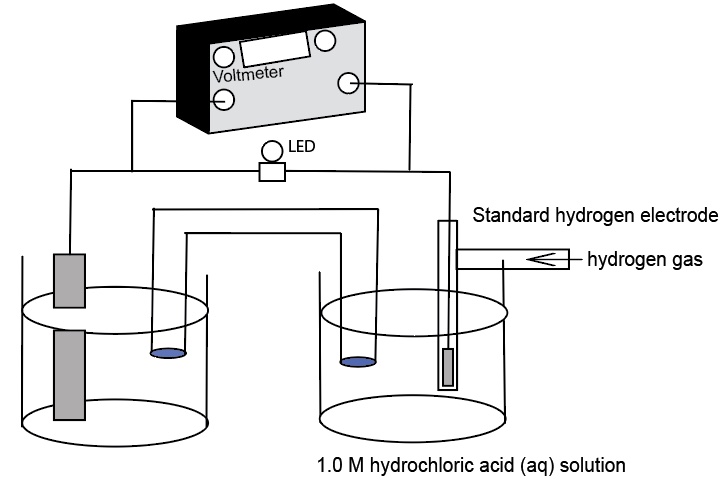
Example of student work
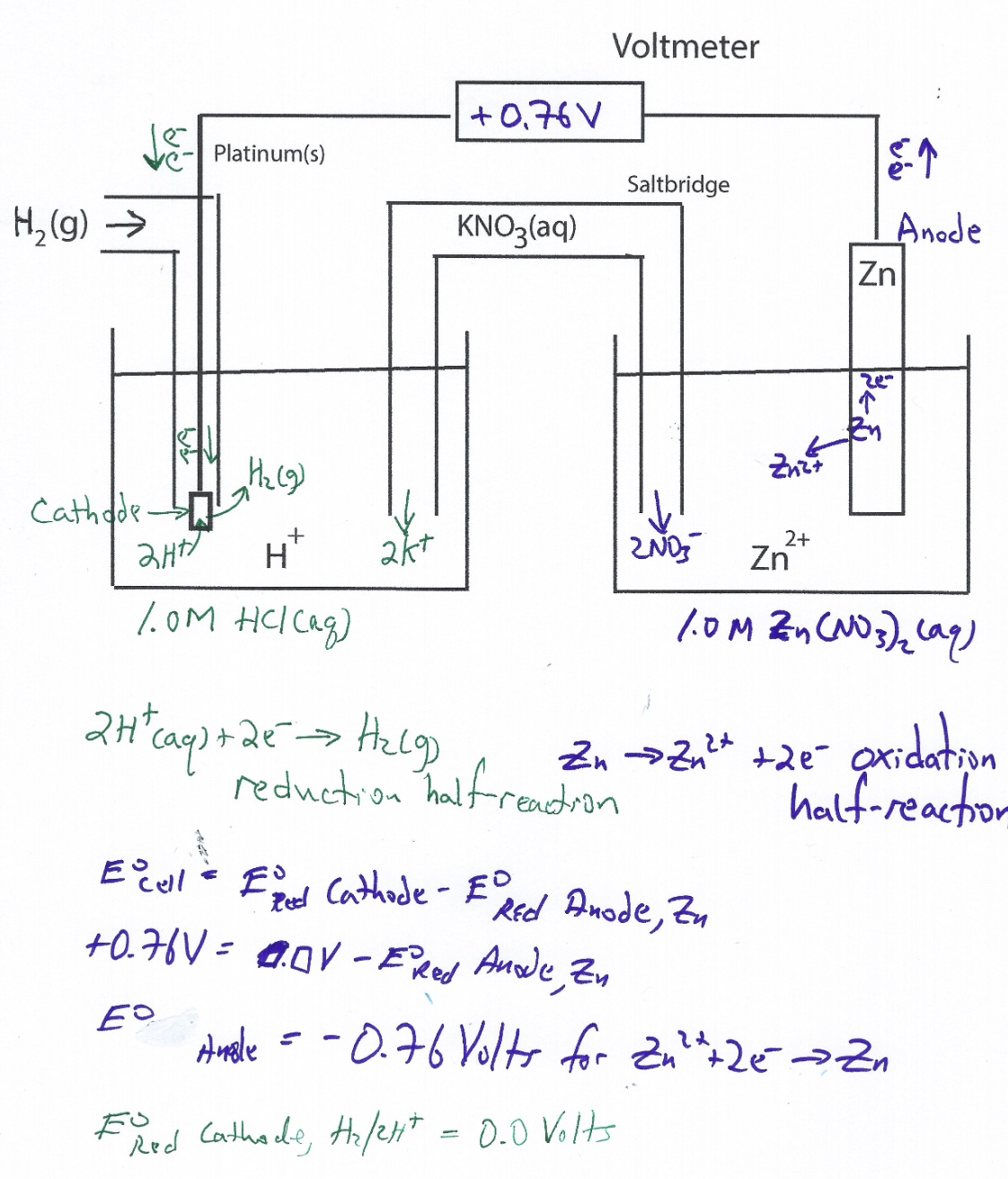
Clicker questions and a Power Point presentation are available to support and enhance the demonstration and the computer simulations & animations of the SHE.
There is an AACT worksheet available to accommpany the simulation. Instructors will need to join AACT and pay a modest yearly fee, which is well worth the price, to gain access to a ton of useful and effective classroom ready resources.
Lecture Presentations on the Zinc - Standard Hydrogen Electrode Electrochemical Cell
There is a decent didatic lecture presentation of a zinc - standard hydrogen electrode electrochemical cell video using a different animation compared to the AACT simulation. Instructors should show this video after students complete work using the AACT worksheeet on the simulation. This video serves a good summary of the zinc - standard hydrogen electrode electrochemical cell.

https://www.youtube.com/watch?v=CQ7gYg64Msc
A didactic lecture demonstration presentation a real zinc - standard hydrogen electrode electrochemical cell is available. Note the connections to the voltmeter improperly shows a negative voltage.
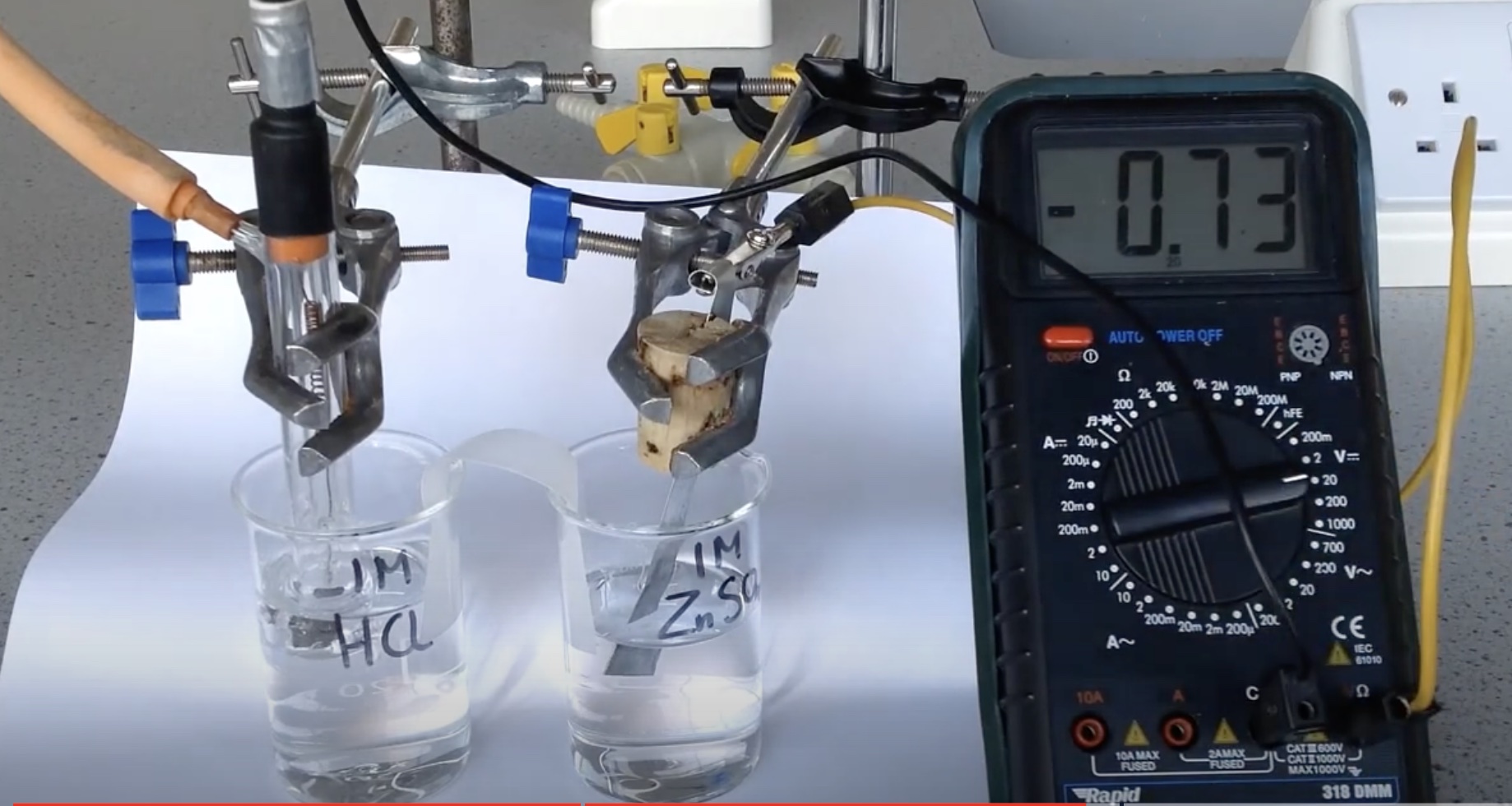
https://www.youtube.com/watch?v=g6YEu_S3d0U (accessed June 2023)
***
Copper - Standard Hydrogen Electrode Electrochemical Cell
For the SHE || Cu2+ | Cu where the SHE is more active compared to copper. The SHE serves as the anode.
An animation at the particle level when the SHE serves as a anode and copper serves as the cathode.
H2(g) --> 2H+(aq) + 2e- (an oxidation half-reaction, occurs at the anode)
ACS AACT https://teachchemistry.org/classroom-resources/voltaic-cells
Greenbowe, T.J.; Gelder, J.I., Boyd, A, Wixon, M. (2020). Galvanic/Voltaic Cells 1. American Chemical Society, American Association of Chemistry Teachers, Washington, D.C.
If you use the simulation, cite the simulation.
The copper electrode, being less active compared to the SHE, is the site of reduction (cathode)
Copper half-cell animation
Cu2++ 2e- -> Cu E° = +0.34 V for SHE||Cu2+|Cu electrochemical cells.
The measured cell potential (emf) is +0.34 Volts. The cell is producing electricity from a chemical reaction, therefore the emf is positive. The 2H+/H2 half cell is a more active system compared to the Cu/Cu2+ system. The 2H+/H2 half cell serves as the anode. An oxidation half reaction occurs at the andoee. The copepr metal serves as the cathode. A reduction half reaction occurs at the cathode.
The emf of a cell is the potential difference between two half-cells. Using the potential difference approach, allows for the determination of E° of the copper half-cell as a reduction reaction.
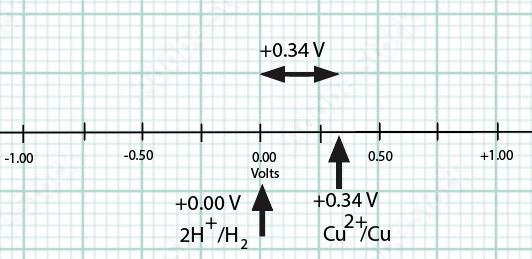
E°cell = E°reduction (Cathode) - E° reduction (Anode)
E°cell =+0.34 V = E°reduction (Cathode) - 0.0 V
E°reduction (Cathode) = +0.34 V + 0.0 V = +0.34 V
Cu2++ 2e- -> Cu E° = +0.34 V
Another didactic lecture presentation and description of a Standard Hydrogen Electrode - video by KEGS. Narration and CC.
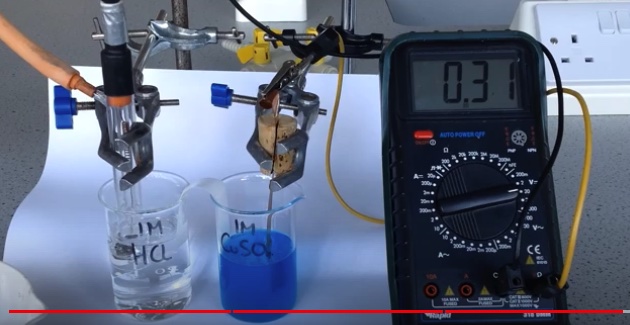
https://www.youtube.com/watch?v=g6YEu_S3d0U (accesssed June 2023)
The copper-SHE cell presentation starts around the two minute and 30 second mark of the video.
Zinc - Copper Electrochemical Cell
Construct a real Zn-Cu cell using the two half-cells and construct a Zn-Cu cell using the AACT Voltaic Cell computer simulation.
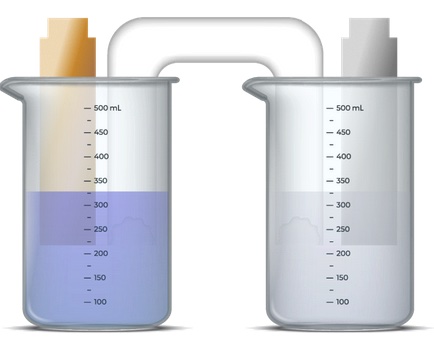
After the individual half-cell emfs are determined, combine the half-cells to give the E° cell for
Zn + Cu2+(aq) -> Zn2+(aq) + Cu E° = ?
Cu2++ 2e- -> Cu E° = +0.34 V
2H+(aq) +2e- -> H2(g, 1 atm) E° = 0.0 V
Zn2++ 2e- -> Zn E° = -0.76 V
E°cell = E°reduction (Cathode) - E° reduction (Anode)
E°cell = +0.34 V - (-0.76 V) = +1.10 V

Curriculum Notes
A Standard Hydrogen Electrode is used to show the E°cell generated: SHE||Cu2+|Cu and Zn|Zn2+||SHE. The effectiveness of this demonstration can be increased by showing computer animations representing what occurs at the anode and cathode of each cell at the particle or atom level.
Computer animations for the SHE electrode (drafts):
Zn|Zn2+||SHE electrochemical cells oxidation half-reaction at the zinc electrode https://vimeo.com/220550690
Zn -> Zn2++ 2e-
reduction half-reaction at SHE https://vimeo.com/220550539 2H+(aq) +2e- -> H2(g, 1 atm) E° = 0.0 V
SHE||Cu2+|Cu electrochemical cell oxidation half-reaction at SHE https://vimeo.com/220550498
H2(g, 1 atm) -> 2H+(aq) +2e- E° = 0.0 V
reduction half-reaction at the copper electrode https://vimeo.com/220550267 Cu2++ 2e- -> Cu E° = +0.34 V
Including the computer simulations & animations provides an excellent opportunity for students to connect the macroscopic, microscopic (particle/atom) and symbolic levels of representation on Johnstone's Triangle.
Zinc - standard hydrogen electrode electrochemical cell computer animation
https://www.youtube.com/watch?v=CQ7gYg64Msc
Clicker questions are available to support and enhance the demonstration and the computer simulations & animations.
Computer Animations Other:
Salt bridge https://vimeo.com/220548484 beta version draft
Zn|Zn2+||SHE electrochemical cells oxidation half-reaction at the zinc electrode Zn|Zn2+ half-cell vimeo.com/220550690
Reduction half-reaction at SHE //vimeo.com/220550539
SHE||Cu2+|Cu electrochemical cell oxidation half-reaction at SHE //vimeo.com/220550498
reduction half-reaction at the copper electrode Cu2+| Cu half cell vimeo.com/220550267
Learning Objectives
1. Describe and identify the components of a Standard Hydrogen Electrode.
2. Write the half-reactions that occurs in a Standard Hydrogen Electrode when it is acting as a cathode. Write the half-reactions that occurs in a Standard Hydrogen Electrode when it is acting as an anode.
3. Explain how a Standard Hydrogen Electrode is used as a reference electrode (E° = 0.0 V) to measure E° half-cell values.
4. Show how a Standard Hydrogen Electrode can be used to rank half-cell reactions and determine an emf series.
5. Show how E° half-cells are combined to give the E° cell.
6. Show that ∆E° is the difference in emf between two half-cell potentials. Use a number line to emphasize this point.
References
Abraham, M.; Gelder, J.; Greenbowe, T. (2007). During Class Inventions and Computer Lab Activities for First and Second Semester General Chemistry. Hayden-McNeil: Plymouth, MI.
Greenbowe, T.J. An Interactive Multimedia Software Program for Exploring Electrochemical Cells. J. Chem. Educ., 1994, 71 (7), p 555.
Greenbowe, T.J.; Gelder, J.I., Boyd, A, Wixon, M. (2020). Galvanic/Voltaic Cells 1. American Chemical Society, American Association of Chemistry Teachers, Washington, D.C. https://teachchemistry.org/classroom-resources/voltaic-cells
Johnstone, A. H. 1993. The development of chemistry teaching: A changing response to changing demand. Journal of Chemical Education, 70(9), 701-705.
Sanger, M.J. and Greenbowe, T.J. (1997). “Student Misconceptions in Electrochemistry: Current Flow in Electrolyte Solutions and the Salt Bridge.” Journal of Chemical Education, 74(7), 819-823.
Sanger, M. J. and Greenbowe, T.J. (1997). “Common Student Misconceptions in Electrochemistry: Galvanic, Electrolytic, and Concentration Cells.” Journal of Research in Science Teaching, 34(4), 377-398.
Sanger, M.J. and Greenbowe, T.J. (1999). “An Analysis of College of Chemistry Textbooks as Sources of Misconception and Errors in Electrochemistry.” Journal of Chemical Education, 76(6), 853-860.
Shakhashiri, B. Z. In Chemical Demonstrations: A Handbook for Teachers of Chemistry; The University of Wisconsin Press: 1992; Vol. 4, p 101-106.
